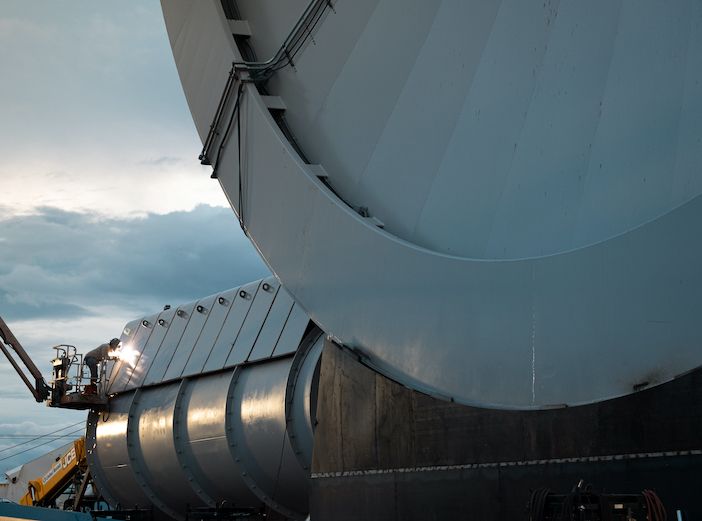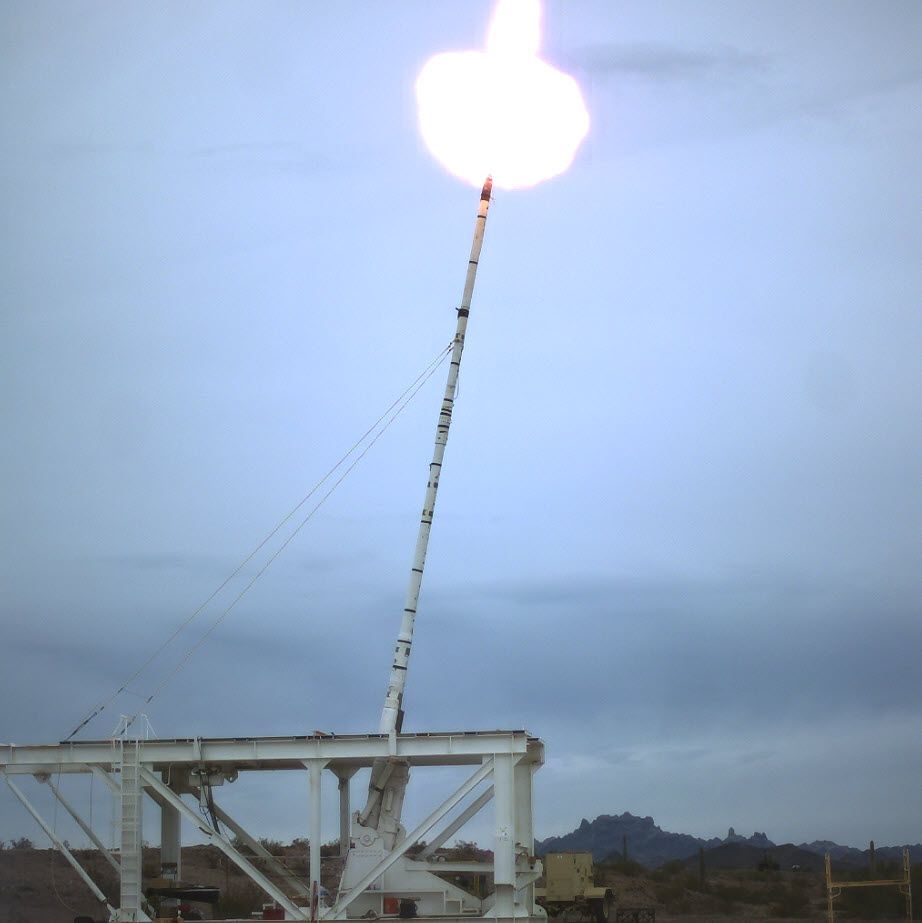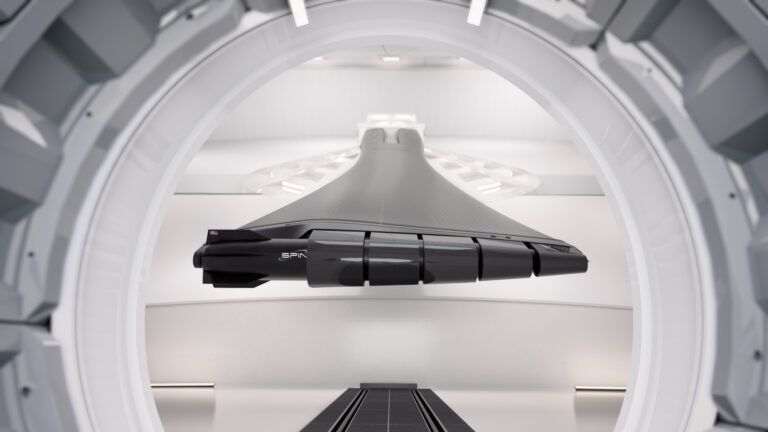by Jack Roper
SpinLaunch is an audacious concept. The company intends to replace multistage rockets with a kinetic space-launch system consisting of a giant centrifuge within a vacuum chamber. Free from aerodynamic drag and aerothermal heating, the centrifuge would spin a launch vehicle to 8,100km/h (5,000mph) speeds on a high-tensile carbon-fiber tether before lobbing it spacewards via an exit-tunnel.
This is no idle hypothesis – SpinLaunch has attracted US$110 million funding and built a 50m (165ft) prototype in preparation for the first commercial launch by 2025.
“An orbital accelerator is a ground-based, reusable, electrically-powered mass accelerator capable of boosting satellites into space,” says SpinLaunch vice president of technology, David Wrenn.
Once the launch vehicle clears Earth’s atmosphere, a low-cost rocket fires it to the 28,000km/h (17,500mph) velocity needed to enter orbit.
“It’s a hybrid system,” explains Wrenn. “A multistage rocket’s first stage represents over 70% of total vehicle mass but provides only 30% of the velocity to reach orbit. Providing even a third of orbital velocity with a
ground-based system creates an exponential reduction in performance requirements.”
Cutting the cost
Space exploration has been built on expensive rocket technology. While SpaceX has reduced the cost of space access to US$2,700/kg on the Falcon Heavy, profligate fuel-burn still produces undesirable emissions and small-satellites call for a more economical paradigm.
“SpinLaunch is about cost, cadence and sustainability,” says Wrenn. “It will push costs closer to terrestrial transportation and operate more like an airport than a spaceport.”
SpinLaunch envisages a thousand annual launches, each booked just days or weeks ahead.
“Rockets are 92% fuel,” Wrenn says. “We can use sustainable electricity and our rocket only produces emissions well above the atmosphere.” Jonathan Yaney conceived the novel rotational system and founded SpinLaunch in 2014.
Compared to alternative launch technologies such as electromagnetic railguns, Wrenn believes SpinLaunch poses only integration challenges and does not require fundamental technical advances. The vacuum chamber, drive system and bearings all leverage proven industrial technologies.
“It’s really about the subsystems,” says Wrenn. “For example, the tether – there are wind turbines now approaching 200m in diameter, so we have the engineering methodologies and supply-chain to build large-scale composite structures.”
A working prototype
Progress from concept to working prototype entailed aggressive hardware development driven by simulation for SpinLaunch. “Coupling those two enabled us to iterate quickly and demonstrate that the fundamental risks could be navigated,” says Wrenn.
Ansys provides the primary simulation toolkit. “Finite element analysis following ASME Code validates the vacuum chamber’s structural soundness,” he explains. “LS-DYNA allows us to model highly transient events, like the release event or complex interactions at high velocities. We validate those models in tests with high-speed cameras operating at over 100,000 frames per second.”
Initial proof of concept testing was done in a 12m (40ft) diameter laboratory accelerator. “We built a low cost, large diameter vacuum chamber by leveraging oil and gas construction methodologies,” says Wrenn.
“It is relatively industrial in quality, but effectively removes aerodynamic drag and aerothermal heating.”
SpinLaunch operated this system at hypersonic speeds Wrenn says, and demonstrated it could safely release rotating projectiles with millisecond precision. “The release was one risk we had to navigate,” he observes. “The exact specifics are in the secret sauce of the company.”
Suborbital accelerator SpinLaunch next proceeded to build a 33m (110ft) diameter suborbital accelerator at Spaceport America in New Mexico, USA (see below “How to build a suborbital accelerator”).

“The 12m system showed it was possible,” says Wrenn. “The 33m system demonstrated it could scale substantially and still remain viable.”
SpinLaunch performed four successful test-shots in late 2021 using the 33m-diameter accelerator. “Those were at low supersonic speeds – about 0.45km/s [1,620km/h],” Wrenn says. “We successfully recovered a carbon-fiber aeroshell flown at supersonic speeds and relaunched it to demonstrate reusability.”
A brief video of a test released online shows an aeroshell bursting from the exit-tunnel through a membrane amid general euphoria amongst the company’s engineers. “A thin membrane holds back the vacuum,” Wrenn explains. “When we pierce it, high-speed doors isolate the chamber and prevent any meaningful air re-entering.”
The membrane is strong enough to contain a vacuum but the aeroshell pierces it without sustaining damage. “Project HARP did hypersonic flight from a vacuum and used a Mylar membrane,” says Wrenn. “That’s the industry heritage.”
Project HARP (High-Altitude Research Project) was a notable SpinLaunch antecedent which launched projectiles from a very large gun led by Canadian engineer Gerald Bull during the 1960s (see Box “Project Harp”) to study the physics of re-entry vehicles in the atmosphere.
The next aim for SpinLaunch is to build a 100m (330ft) diameter orbital accelerator for commercial launches. “The 12m and 33m systems removed the fundamental risks,” claims Wrenn. “Now it’s just scaling and engineering work we need to do.”
The release methodology, airlocks, rotor dynamics and fluid film bearing architecture should readily translate to 100m scale, with some aspects of the system becoming easier, believes Wrenn. “The volume scales to the third power,” he says. “Any air which enters is a smaller proportion of the total volume, so the airlock performance requirement is lower.” Reaching 8,100km/h also requires fewer RPM at a greater diameter.
“In the laboratory, we have operated above 2km/s [7,200km/h] – the fastest speed ever achieved by a physical rotating system,” says Wrenn. “That requires thousands of RPM at 12m scale, but about 450 on a 100m system.”
Regulatory approval
With a year of final design work to do and two years spent building, SpinLaunch is aiming for its orbital system to come online in 2025. It is working with the FAA on regulatory approval. “They understand we are a high-cadence system,” says Wrenn. “SpinLaunch influenced recent evolutions of the Part 450 launch-site development standard.”
But what are the safety discussions around a 100m-wide, 8,100km/h rotational system? “Rockets are missile technology,” replies Wrenn. “They’re full of fuel and it’s always possible they can turn sideways. But our vehicle will have a guaranteed ballistic flight-profile.”
Hydrogen impulse launchers
After HARP concluded, Dr John Hunter led a three-year project at Lawrence Livermore National Laboratory in 1992 called Super HARP. The program used a two-stage L-shaped light-gas gun with an 82m (270ft) combustion and pump-tube section perpendicular to a 47m (155ft) launch-tube. Igniting a methane mixture drove a 1 tonne piston down the pump tube, where hydrogen became rapidly compressed and drove a projectile down the launch tube. Super HARP achieved 10,800km/h (6,700mph) velocities before funding was discontinued in 1995.
Today, Hunter is chief operating officer of Green Launch. He says, “People have looked at magnetic guns and laser propulsion. Nuclear rockets provide high specific impulses but emit fissile products.” Hunter believes a hydrogen-fueled impulse launcher akin to the Super HARP gun can launch satellites at higher velocities than SpinLaunch and at a fraction of the cost.
“Laboratory hydrogen systems have demonstrated 11km/s [39,600km/h],” he says. “We don’t need to speculate – we have the data.”
Green Launch’s system targets projectile speeds of up to 14,400km/h (9,000mph) with a two-stage combustion launcher. But for second-phase speeds of up to 32,400km/h (20,100mph) it proposes a pure hydrogen system.
“That’s a high-end version with no explosion,” Hunter explains. “We simply heat a proprietary hydrogen mixture to get a high sound-speed in the medium, then release the hounds.”
Green Launch has built a combustion-based impulse launcher from a modified 17m (56ft) surplus barrel and recently conducted 28 shots at Yuma Proving Ground.
“We got 2km/s [7,200km/h] from that system with a modicum of work,” says Hunter. “We did a shot in December which looked to reach about 30km, but we don’t have tracking data because the radar couldn’t acquire it.”

Green Launch’s next objective is to fire a payload across the 100km (62mile) Kármán line as proof of concept. Ultimately, a hybrid system will launch vehicles at 21,600km/h (13,400mph) to 300km (186 mile) apogee, whereupon rockets will provide the velocity to circularize orbit. Hunter envisages Green Launch as the FedEx of space access.
“We want to supply small packages, just in time, to unusual orbits,” Hunter says. “You can’t deploy one satellite in five hours with a Falcon 9 – unless you pay US$50 million for a 20kg launch.”
Hunter believes its relatively simple technology has enabled Green Launch to quickly achieve 7,200km/h speeds, but he is skeptical of SpinLaunch attaining its goals.
“The Department of Energy spent millions on ultracentrifuges in the 1990s, but couldn’t get above a 1.4km/s [5,000km/h] tip-speed without blowing them up,” he says.
But while SpinLaunch has financial backing from partners like Airbus and Google, Green Launch must now raise funds for its next phase.
“We’ve done the project for under US$1 million, which is coffee-money to some richer organizations,” says Hunter.
“If we had $20 million, we could build an orbital system and launch 10kg packages to LEO in two years.”
“We can customize our system to work with carbon dioxide, which is abundant on Mars,” says Green Launch business development director, Eric Robinson. “We could have an Earth-Moon-Mars triangle and shoot things around efficiently.”
The role technology such as SpinLaunch and Green Launch play in the future Space industry remains to be seen. Both systems produce so much g-force they are unsuitable for human use.
Robinson says, “We only want to take 90% of space cargo: the fuel, water, building supplies and electronics. We can leave 10% for the rocket people.”
Meanwhile, SpinLaunch has an active launch contract with the US Defense Innovation Unit. “They’ve been a great advocate and laid our groundwork for future customer interactions,” says Wrenn.
SpinLaunch is also developing satellite components to withstand the centripetal acceleration of kinetic launch. “We’ve developed reaction wheels, solar panels and spring-loaded hinges,” Wrenn says. “We iterate quickly through simulation and testing, leveraging the 12m [40ft] system to test components and 33m [108ft] system to qualify entire satellites.”
Wrenn believes that SpinLaunch could reshape space access. “The International Space Station is a 400 tonne structure supporting six astronauts. That is a huge infrastructure to human mass ratio. Building an in-space civilization would mean launching tens of thousands of tonnes of supporting infrastructure.
“We have a chance to provide humanity with a sustainable, low-cost method for doing that.”
How to build a suborbital accelerator
SpinLaunch’s 33m (108ft)-diameter suborbital accelerator at Spaceport America, New Mexico cost US$38 million and is 50.4m (165ft) tall. SpinLaunch broke ground in 2019 and conducted its first successful launch on October 22 2021. “By diameter, it is the largest free-standing vacuum-chamber on Earth,” says SpinLaunch’s vice president of technology, David Wrenn.
“We’ve successfully upscaled to a 33m system which will conduct atmospheric flights, a key stepping-stone to technological maturity.
“We’ve launched into the atmosphere while maintaining the vacuum in the chamber. As the launch vehicle flies out of the system, a high-speed airlock closes behind it – about three times faster than the blink of an eye.”
The system will provide a development testbed for the Orbital Accelerator, SpinLaunch’s 100m (328ft)-diameter commercial system.
“It was crucial to navigate the rotor dynamics at 33m scale,” says Wrenn. “We had to understand the composite tether’s natural frequencies and how it vibrates at different speeds based on its dynamic stiffness and nuances of bearing stiffness. Those insights and methodologies will enable the orbital system.”
The 1000 tonne vacuum chamber is evacuated by an underground plant and its adjustable cradle provides launch-angle articulation. Construction in the desert was challenging.
“The remoteness and extremes of temperature meant we also had to build life-support systems out there for construction staff. The foundation was about 6,350 tonnes of steel and concrete,” he continues.
“We had no playbook to work from and the environment threw plenty at us. But we’ve emerged with an adaptable construction team that knows how to operate in challenging conditions.”
This may prove useful, with the company considering orbital launch-sites in Alaska.
Project HARP
Project HARP (High-Altitude Research Project) was a notable SpinLaunch antecedent led by Canadian engineer Gerald Bull during the 1960s.
Bull believed superguns offered a cost-effective space launch mechanism. In 1962, HARP established a 16in US Navy artillery gun on Barbados with two 140-tonne tubes pointing skywards.
By 1966, HARP had fired 80 shots and built guns in Quebec and the Yuma Proving Ground, Arizona. In 1966, the Yuma gun launched a projectile at 7,560km/h (4,700mph) which set a 179km (111 miles) world altitude record and crossed the Kármán line into space. The funding dried up in 1967 and Bull was assassinated in 1990 while working on an Iraqi supergun.





